|
- Catalog (in stock)
- Back-Catalog
- Mail Order
- Online Order
- Sounds
- Instruments
- Projects
- History Face
- ten years 87-97
- Review Face
- our friends
- Albis Face
- Albis - Photos
- Albis Work
- Links
- Home
- Contact
- Profil YouTube
- Overton Network
P & C December 1998
- Face Music / Albi
- last update 03-2016
|
1. Ayb, Ben, Gim - 2:23
2. Zmpik, Zmpik, Zarina - dance song - Province of Shirak - 1:27
3. Arev, Arev, Ari Doos - Van, Vaspurakan region - 1:10
4. Arev, Arev, Yek, Yek - 0:58
5. Tsam is Torge - dance song - 2:44
6. Jakhraki Vot / Vostana Bartsrik Sarer - humorous song - 3:26
7. Teshik Manogh Nargizu - work song - 1:10
8. Avetis - ceremonial song - Van, Vaspurakan region - 1:21
9. Msho Avetis - ceremonial song - Mush, Taron region - 1:06
10. En Dizan - ceremonial song - 1:11
11. En Dizan - ceremonial song - 0:58
12. Hanik, Nanik, Nanarik - dance song - 2:47
13. Arorn oo Tatraku - ceremonial song - 3:19
14. Krunkner, Barov Yekak - Sasun, Taron region - 1:19
15. Poormatikinn Eker E - ceremonial song - Balu, Kharpert region - 2:27
16. Hayr Mer - ceremonial song - 2:16
17. Ankanim Arachi Ko - ceremonial song - 1:08
18. Tsov Kentsaghuys - ceremonial song - 0:51
19. Ay, Lorik - 2:43
20. Hing Edz Unem Ulerov - work song - 0:25
21. Hing Edz Unem Ulerov - work song - 1:07
22. Garnookn oo Mayru - 1:25
23. Kakavik - 1:59
24. Gatsek, Tesek - ceremonial song - Mush, Taron region / Van, Vaspurakan region - 2:28
25. Tesek Aghavnin - patriotic song - Van, Vaspurakan region - 1:55
26. Goghtan Mankti - patriotic song - Van, Vaspurakan region - 1:55
27. Shogher Djan - 1:05
28. Djan Garnook - Mush, Taron region - 1:41
29. Tiramor Govku - ceremonial song - 3:35
30. Maratouk, Astvatsatsin - ceremonial song - Sasun / Mush, Taron region - 3:42
31. Antsrevn Yekav - 1:15
32. Roori, Roori - lullaby - Sasun, Taron region - 2:24
33. Payte Tsiook - 0:56
34. Aghves Parkets Jampi Takin - humorous song - Shatakh, Taron region - 0:35
35. Aghves - humorous song - Shatakh, Taron region - 1:15
36. Dan, Dan, Dan e Dan - humorous song - 0:40
37. Haburban - 3:14
- Unfortunately, while recording songs, Komitas did not usually note the song’s origin, as to which region or province it may have come from. Komitas recorded songs at the end of the 19th and beginning of the 20th century, from Armenians living in the plains of Ararat. Of course, many of these songs had roots in Western Armenia in Mush, Sasun, Van and many other places and regions. But since songs have been passed to us by word of mouth, from generation to generation, it is clear that the songs have the distinct peculiarities of each region. Thus, the following songs in this recording are considered to be songs of Echmiadzin and the provinces of Ararat: “Ay, Lorik”, “Avetis”, “Dan, Dan, Dan e Dan,” “En Dizan”, “Ayb, Bem, Gim”, Teshik Manogh Nargizu", and others.
Hayrik Mouradian Traditional Song and Dance Ensemble
- Hasmik Harutyunyan (Artistic Director)
Hasmik was born in Yerevan in 1960. Her ancestors are from Mush. She graduated from the Department of Vocal Music at the Arno Babajanyan School of Music and the Yerevan State Pedagogical Institute. For several years, she worked as soloist for the “Agoonk” Ensemble of Armenian National Radio. Hasmik is a member of the Karot Ensemble and is vocalist for the Shoghaken Folk Ensemble.
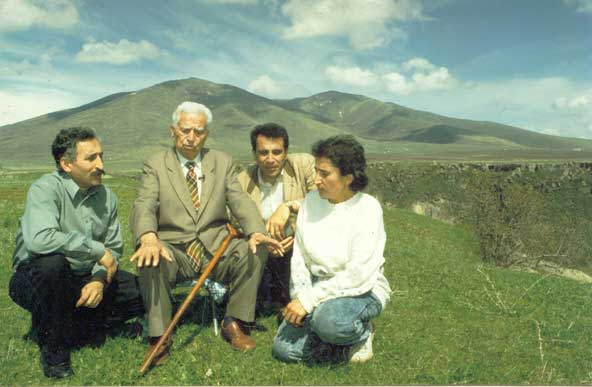
Rudik Haroyan (dance instructor), Hayrik Mouradian, Aleksan and Hasmik Harutyunyan
- Hayrik Mouradian
Hayrik Mouradian was born in 1905 in the region of Shatakh, near Lake Van. “From childhood, I listened to and loved the songs of our ancestors,” he said. “My mother, Zozan, was a fine singer, as was my aunt Sinam. I learned folk and epic songs, and from another relative, patriotic songs.” But, that world came to a tragic end, and Hayrik, his family, and the Armenians of Shatakh and all of Western Armenia were expelled from their homeland, their hearths, and the place of their old ways.
Hayrik was ten years old when they left Shatakh. They reached Salmast, in Iran, and then the deserts of Iraq. Of fifty-four family members, only four survived, including Hayrik, his brother, mother, and an uncle. In 1921, they moved to the Artashat region of Armenia. Hayrik spent his adult life working as a historian and singing the songs he learned as a youth in his beloved Shatakh.
The Hayrik Mouradian Traditional Song and Dance Children's Ensemble was founded in 1996 by his student, Hasmik Harutyunyan, who serves as the group’s artistic director. “We lost much in the massacres,” Hayrik said. “My greatest wish is that you, the children, keep this music, something sacred to all of us, alive. These songs tell the stories of our lives, with their struggles, happiness, sadness, feelings, and the history of our nation. The songs will help you grow and become good, intelligent people. I don’t consider our old world lost, as you children will bear the strength of these songs.” Talking to parents and elders, Hayrik said: “Remember, when you are angry with children, they are flowers of nature."
|
- Anoosh Harutyunyan was born in 1987 in Yerevan. She attends the Tigranyan Music School in the Department of Piano, and studies English at the Brusov Institute of Foreign Languages in Yerevan. |
|
- Aram Harutyunyan was born in 1992 in Yerevan. He attends the Tchaikovsky Music School where is studying the vocal tradition. |
|
- Aroosiak Harutyunyan was born in 1989 in Yerevan. She attends the Derenik Demirjyan School in Yerevan. |
|
- Hayk Harutyunyan was born in 1997 in Yerevan, and is a brother of Anoosh and Aroosiak Harutyunyan. Hayk attends the Derenik Demirjyan School in Yerevan. |
|
- Lilit Harutyunyan was born in 1990 in Yerevan. She attends the Tchaikovsky Special School of Music in the Department of Piano. |
|
- Mane Babayan was born in 1994 in Yerevan. She attends the Sayat Nova Music School, where she is studying the flute. |
|
- Mane Nikoghosyan was born in 1990 in Yerevan. She attends the Mushegh Ishkhan School and the Aleksander Spendiaryan Music School in Yerevan, where she is studying vocal music. |
|
- Mavrik Mkrtchyan was born in 1990 in Javakhk, an Armenian region in southern Georgia. He is studying vocal at the Tchaikovsky Music School. |
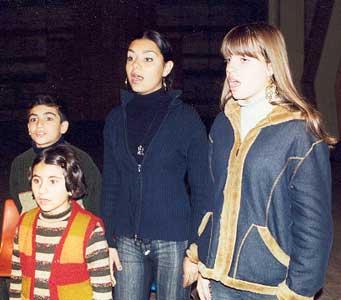
Aram Harutyunyan, Mane Babayan,
Anoosh and Aroosiak Harutyunyan
|
|
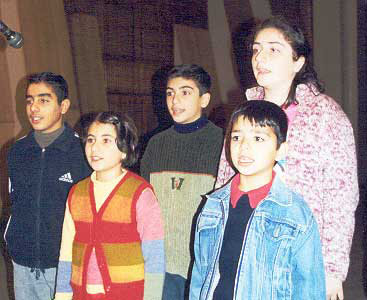
Mavrik Mkrtchyan, Mane Babayan
Aram, Hayk and Lilit Harutyunyan
|
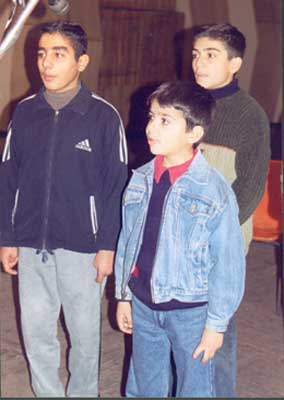
Mavrik Mkrtchyan, Hayk and
Aram Harutyunyan
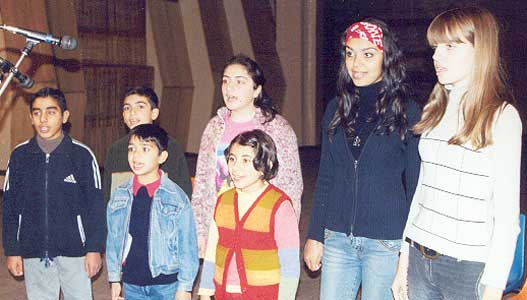
Mavrik Mkrtchyan, Aram, Hayk, Lilit Harutyunyan, Mane Babayan, Anoosh, Aroosiak Harutyunyan
Folk Songs
The song is the echo from a people’s soul, expressing its history, method of movement, heart and mind, strength and enthusiasm, hope and faith, the call from his soul, and, of its ceremonies and existence, "Mystery and Meaning" - Komitas.
Folk songs have always reflected a people’s inner world and carries the wisdom that the people have accumulated over the centuries, during good and bad days. “In this way, for example, as the child who is newly learning and depending on the intellectual world for his life’s activities, his method of expression is plain, short, and bears an explanatory style. Since the youth is growing both in his inner and outer world, his method of expressing himself step-by-step becomes more advanced, and it includes and bears these advancements. When the child becomes an advanced, organized person, his methods of expression become deeper, more distinct, and in deeper harmony with the world.” (Komitas, Articles and Studies, Yerevan, 1941).
Folk music is widely varied, with different character and genres.
|
- Work songs, including women's work songs and "horovels", that is plowing songs or songs of the field. All work songs describe something of the working process and are sung to accompany work. Songs of the fields are called "horovels". This is a large, manysided genre, in which the peasant expresses his thoughts, desires, and his love for the nature, all combined with a deep respect for his work. Singing helps him, not only during the period of work, but to endure and overcome the trials and difficulties of life. |
|
- Ceremonial songs (i.e. for weddings, funerals etc.) Ceremonial songs are sung at weddings, at funerals (songs of sadness and mourning) and on various other holidays and at festive celebrations. Every ceremony or holiday has its particular ceremonial song. The roots of this genre are to be found in pagan times, but with the beginning of the Christian era, they have assumed new meanings and a new importance, which they have maintained till today. |
|
- Epic songs
In Armenian music tradition, epic songs are thematically distinct in two categories. |
|
- 1. The one with the bigger repertory contains mythological themes of pagan Armenia like "Haik and Bel", "Dork Angegh", "Ara and Shamiram" and those classified as "fables" |
|
- 2. The others are the so-called heroic songs telling about the history and the traditions of these people and their heroes, such as e.g. "Sasuntzi Davith" dealing with the adventures of the hero of epics David of Sasun in his defense against infidel Arab invaders from Egypt and Persia. |
|
The epic was based on oral tradition that presumably dates from the 8th to the 10th century; it was widely known from the 16th through the 19th century and was finally written down in 1873. |
|
- Historical songs - These songs reflect Armenian history and reality. Through such songs, we can learn about the real events of Armenian history in various times. |
|
- Dance songs (songs sung during a dance). Dance songs are often combined with some kind of game. The songs are usually short and they are sung during group dancing. The names of some of these songs are "Khagh, Yaili, Gyond, Taghaloo and Mani". The roots of these songs are hidden in the pagan era, emerging again at the same time as the ceremonial songs. The main theme of this genre is love for the nature and for life, or for a person. Dance songs can be distinguished by their repetitive movements that reflect a short series of steps, which are repeated many times. Dance songs are always happy songs |
|
- Humorous songs - Humorous songs provide a unique method for people to understand and judge man's everyday weaknesses (jealousy, greed, etc.) as well as to offer acceptable moral limits to them. In this type of music, the meaning is similar to that of the dance song, where the rhythm, or the tempo, plays an important role. The songs reveal in this way their contents or meaning.
|
|
- Lullabies - Lullabie belong to the oldest musical genre created by man. Well-known Armenian lullabies are "Nana, Loorig, Roorig, Ayer, Hayroor" and others. The main theme of a lullaby is the love for the child. Various subjects or feelings are expressed in lullabies, when the mother is rocking the cradle and singing, forgetting her daily burden, remembering past loves, embracing touching memories. Doing so, she is also passing past lamentations to the next generation, thus awakening in the young heart a heroic soul and the feeling for the homeland. |
|
- Lyric songs, love songs - Lyric songs make up the largest part of the Armenian folk song repertory. The themes are manifold including love, social uncertainties and upheavals, tragedies suffered under foreign rule, and various deep expressions of the soul and life. |
|
- Songs of the emigrants (these songs tell stories about tragedy, persecution, emigration, torture, and the grief of the Armenian people). In Armenian popular culture, the emigrant's song is also called "Anduni", meaning one who, without choice, must leave his home. These songs tell the story of emigrants, who were forced to leave the country and search for good fortune and happiness, but their hearts are burning from a deep longing and grief, and the spiritual and psychological pressures of their life. Classic examples of this genre are "Kroonk", (The crane), and "Anduni" (Homeless). |
“In the village everybody can sing; because everybody participates in the creation of the song, or the song’s lyrics. But nobody knows who has created the playful song and dance.
Children have always been participants in all rites, ceremonies, happiness, and work processes. The child quickly absorbs each new and interesting thing he meets. He wants to help his grandfather and father in working with the land, and share household duties with his mother and grandmother, and participate in all ceremonies and gatherings; all this time he absorbs this new world in his own, private way and learns to live, rejoice, sing, dance, and work.
The place and method of learning a song
“It is very interesting for village children to see the process of song and dance. They enter from this or that opening, from left and right amongst the grandfathers and grandmothers, listening to the singers, mimicking their movements, closing and opening their mouths, without thinking, all of which the child’s mind easily grasps and then, with confidence, expresses, or sings, this music.”
“When the game, or song, has finished, the child runs to some corner and tries to repeat everything he has heard. They like the shortness of the song, and the simple repetitions. They aren’t interested in the least with the lyrics, because the meaning is likely not understandable to them.”
In the words of Hayrig Mouradian: “There was a tradition in our mountainous country - in summer and fall, we built large fires, and gathered around the fires, sitting on logs and branches, and told our thoughts and feelings, daily problems, told stories and fables, sang, and laughed. In these historical, patriarchal villages, these gatherings were events where villagers sang and performed their songs and recitations, singing their versions of the song.”The song passes from mouth to mouth, from generation to generation.
The spread of the national song made important strides in village schools, where teachers taught these songs in a simple, dedicated manner - true songs of the village, of the countryside. At these schools, children happily learned these songs and took them home, singing them at their family hearth, where foreign influences and styles had already reached.
The method of protecting and spreading the folk song is mainly by way of ceremonies such as weddings, festivities, and pilgrimages. Both religious ceremonies and weddings are always accompanied by music. Revered places of pilgrimage were the monasteries of Narek, Varaga, Aghtamar, Pootka, and St. Gevorg, and the church of St. Mary on the mountain Maratouk. Every year, pilgrims would bring new and old folk songs and dances to these places. The pilgrimages became showcases of folk music, pilgrims returning to their patriarchal villages with news songs, new enthusiasm.
The most simple and basic kind of folk song is the children’s song. Children’s folk songs are a genre that is much loved and easily spread; children learn these songs very quickly and happily. The songs are at times simple, yet at other times serious and ingenious. Very often, the song presents interesting questions and answers or teaches fables, tales, and the alphabet, as in songs where the speed in which the song is sung helps the child speak better and faster, along with the initial purpose of learning the alphabet.
Also, a large number of songs exist which, although not pure children’s songs, have been absorbed into the genre and become their own, and are performed and loved as all true children’s folk songs.
Long ago, it was proved that the child, in his clear, simple mentality, is able to differentiate, without missing anything, the worth of what is open and honest, and that now they sing these songs that captivated their wishes and filled their colorful imagination. The child’s mind still isn’t weighed down by rules, laws, and the heavy burden of traditions, thus he understands the world as a fable, where it is possible to speak with birds and the sun, and also as a grown person, directing his prayers to God, or holding a doll and rocking it to sleep with a lullaby. In other words, the child feels himself a true member of this world, and the universe, and feels that these sentiments and feelings help him understand and absorb the world and strengthen the course of his life, line-by-line, page-by-page.
In this recording, a series of much-loved children’s folk songs are presented, songs of different character and realities, which are sung taking special care to preserve their distinct styles and rhythms. Also in this recording arrangements of children’s songs by Komitas are found, written especially for children attending the Gevorgyan School in Echmiadzin and the Nikoghosyan School in Constantinople. In these arrangements we meet Komitas the teacher, who, for the people and especially for children, was deeply concerned about the education of his people. Realizing the importance of this work, Komitas went on to assign his students the task of writing and teaching folk songs to others. Further proof of Komitas’ concern for children and their songs are songs he arranged for piano.
The songs
As has already been said, the child communicates in a free, unbridled way with the natural world. Is it not true that the child is a part of this world, even though a small part, yet very important. The child appeals to the sun, as he would a friend, asking the sun to come out from behind the clouds, promising his precious raisins, which he is ready to share with the sun, if only the sun will play with him see: “Arev, Arev, Ari Doos" and “Arev, Arev, Yek, Yek".
Everyone knows the love children have for birds. Nearly all Armenian children know the songs “Kakavik” (Partridge) and “Ay, Lorik” (Quail). The flowing, beautiful melodies and easily remembered lyrics are remembered by all until adulthood, when they are then passed on to the next generation, our children.
For children, life is an interesting and great game, where the toys are the natural world and its objects.
| 3. |
Arev, Arev, Ari Doos - sun, sun, come out |
|
- Mane Babayan (soloist) and Ensemble - Levon Tevanyan, shvi |
|
A song where the child asks the sun to come out and play, as he would ask a typical playmate. Komitas learned it from a recording by Tigran Jituni, who was from Van in Western Armenia. It is sung while playing a game related to “hide and seek”. |
|
Sun, sun, come out,
we brought you the light of your eyes.
Your sister, the moon, brought a plate of raisins.
A cloud came, the sky darkened,
the raisins stayed hidden in the darkness.
Reveal your face, sun, we’ll give you a handful of raisins.
|
| 4. |
Arev, Arev, Yek, Yek - sun, sun, come, come
|
|
- Ensemble - Levon Tevanyan, shvi |
|
Another song where the child appeals to the sun to come out and play. It is an example where a child communicates with an object of nature, in this case the sun. |
|
Sun, sun, come, come. // Come and shine on the colorful rock.
Black, black clouds, go away from here, // give a path for the sun.
|
| 23. |
Kakavik - partridge |
|
- Lilit Harutyunyan (soloist) and Anoosh Harutyunyan - Karine Hovhannisyan, kanun |
|
This song was published for the first time in 1908. Here the words are arranged by Hovhannes Tumanyan, and the music by Komitas.
|
|
The sun opened from dark clouds. // The partridge flew from a green mountain.
From the green mountain, the edge of the mountain.
Bringing greetings from the flowers. // Pretty, beautiful, // pretty, colorful partridge.
|
| 19. |
Ay, Lorik - quail |
|
- Ensemble - Karine Hovhannisyan, kanun - Levon Tevanyan, tav shvi - Kamo Khachatryan, dhol
|
|
A song about a bird, the quail, portraying the great love children have for birds. |
|
The morning wind blew, // the field billowed and became an ocean.
A partridge flew from the field, // it flew and flew on the mountain and into the canyon.
Aye, partridge, dear partridge, // round and fat.
|
The next song, is about a boy’s beloved horse, which, for no reason, turns into a steed, when the boy grows up. This kind of song teaches our future brave soldiers to protect our country and our mothers.
| 33. |
Payte Tsiook - wooden horse |
|
- Hayk Harutyunyan (soloist) |
|
A song about a boy's horse. The song was written by Komitas. |
|
Clump, clump, clump, // run, horse, hop, // over the rocks, // over the hill,
pretty horse, // towards the mountain. // Clump, clump, clump, // hop, hop, hop.
|
The next a lullaby, by nature, isn’t a children’s song, but it is clear to everyone that the small girl’s precious game, caring for her doll, and putting her to sleep, is important to her, as it is for her mother.
| 32. |
Roori, Roori - rock, rock
|
|
- Mane Nikoghosyan, Aroosh, Aroosiak and Lilit Harutyunyan (soloists) - Ensemble (girls) |
|
A lullaby of Sasun. One of the simplest lullabies. |
|
Rock, rock,
Rock, rock.
I say rock, you rock. // You are small, grow with goodness.
Let the south wind rock you. // Rock, son.
|
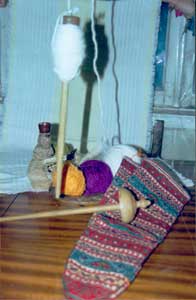
Ilik, or teshik
|
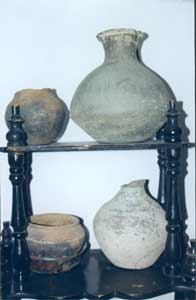
Clay
|
| Ilik, or teshik |
... special tools called sanderk are used in Armenia to card wool. The wool is then weaved by the ilik (and teshik and jakharak) into thread. The person picks up some of the wool, with their hands make it longer and string-like, and they attach it to the ilik. Then they hang the ilik downward, and twist and turned the ilik, which begins to turn by itself. During this process, the person takes hold of this wool and helps form it into thread. |
| Clay |
...clay pitcher-used in Armenia for any kind of liquid, and, if wider in shape, cheese or madzoon (yoghurt) can be stored. |
Girls learn to weave and sew from their mothers, and that work is more interesting, and becomes like a game, when singing the wonderful song like “Teshik Manogh Nargizu", which is one of the first children’s work song. This series also includes the song “Hing Edz Unem Ulerov", where it is told how to take care of a goat - how cream and oil are taken from milk - to help the young girl learn to be the woman of the household.
| 7. |
Teshik Manogh Nargizu - thread weaver nargis |
|
- Anoosh, Lilit Harutyunyan, Mane Babayan, Mane Nikoghosyan (soloists) and Ensemble |
|
A work song from Van. It is a song in the work genre, where thread is being weaved. |
|
She took the needle and rubbed her shirt. // Kstfer, kstfer (sound of rubbing).
The hook on the needle is made from silver. // The needle is like a rose.
Nargis’ apron is made of delicate leather. // My Nargis is very young and beautiful.
|
| 20. |
Hing Edz Unem Ulerov - I have five baby goats
|
|
- Aram, Hayk Harutyunyan (soloists) and Ensemble |
|
A song of humor (work song) about stinginess and poverty. It was recorded by Komitas in Echmiadzin in 1909, from those who had fled pogroms in Turkey. |
|
I have five baby goats. // I milk many buckets.
I gather a gal (form of measurement, large amount)
But take oil only the size of a tig (form of measurement, very small amount).
|
| 21. |
Hing Edz Unem Ulerov - I have five baby goats
|
|
- Lilit and Aram Harutyunyan |
|
Another version of a work song by the same name.
|
The child’s understanding of the world continues during the time ceremonies are being enacted. In the series of songs about rainbows, “Poorrnatikinn Eker E” is performed on the holiday of Vardavar, the day of water worship. The worship of water and flowers represents, in this case, fertility. In pagan times, Vardavar was one of many holidays dedicated to the goddess Anahit.
| 15. |
Poormatikinn Eker E - poormatik came (doll made for ancient ceremonies, especially water worship "Vardavar")
|
|
- Anoosh, Aram, Lilit Harutyunyan, Mane Babayan, Mane Nikoghosyan (soloists) and Ensemble
- Gevorg Dabaghyan, duduk - Grigor Takushyan, dham duduk - Kamo Khachatryan, dhol |
|
This song originates in the town of Balu, located near Kharpert. The words are very colorful and varied, thus its use in several holidays and celebrations in Armenia. It is sung by children as they hold specially made dolls as they run from house to house.
|
|
The doll has come.
Wearing a precious shirt and red hat.
And her head wrapped with a scarf.
She wants bulghur from a large jar, // and from a small vase, salt.
|
The next song is one of the large genres of children’s songs that demand flexibility and a good memory, as during the singing of this song the speed becomes gradually faster. This song is connected with Barekendan, the first holiday of spring, which heralds the awakening of nature and the resulting work activities and the wish for a successful harvest “berku bari lini” (let the harvest be good).
| 24. |
Gatsek, Tesek - go, see
|
|
- Anoosh, Aram, Hayk, Lilit Harutyunyan, Mane Babayan, Mane Nikoghosyan, (soloists) and Ensemble |
|
This version has elements from the regions of Mush and Van. Yet the song’s origin is in Mush. This song has dialectal influences from both places, much as the dialects in both areas are different, as well as the style and accent of the music. |
|
Go, see who has eaten the bush. // We went, and saw a goat had eaten the bush.
The goat was by the bush. // The bush by the vineyard.
The vineyard starts from Varakavank (monastery near Lake Van)
and reaches me. // Happy holiday to you, // and Happy Easter to us.
|
A special genre of sacred songs is called “Avetis” (means ‘good news’ in Armenia). These old songs have penetrated into the music. The style has been strictly passed, by word of mouth, from generation to generation. Now there are almost limitless songs in this genre, sung in different styles and melodies, yet the lyrics and meaning are one and the same, the only possible difference being in the dialect.
In the “Avetis” songs the most simple rhythm and syllabic measurements of the “sharakans” (sacred songs) and psalms have been made part of the distinct mould of the folk dance.
The “Avetis” songs, in that they are songs spreading “good news”, reveal especially events such as the birth and resurrection of Christ, and other holidays of a religious nature. But, in essence, they are sung during the above-mentioned times, those of the birth and resurrection of Christ. The birth of Christ, celebrated as Christmas, runs parallel with New Year celebrations, where the child will become overjoyed by receiving many presents, yet the resurrection of Christ, celebrated as Easter, becomes a different source of joy, as the conclusion of the forty day Great Fast leads to great-tasting food and celebrations, including many happy songs (“Avetis Dznndyan”, “Avetis Meds Zatiki”), meaning “News of Christ’s Birth” and “News of Easter”.

Doll
|

Khachbur
|
| Doll |
... these small dolls are made and taken the church for the holiday Vardavar (day of water worship). Children held the dolls and pretendend they were singing and dancing, as they would puppets, and sprinklet water on them.The purpose was to influence nature, so nature would see what people were doing, and ensure there would by plenty of water for the fields, so the harvests would be good (plentiful). |
| Khachbur |
... a tradition during the holiday Vardavar was to take husks of wheat to the church. They made crosses out of bunches of this wheat, by tying them together. This is khachbur. Again, done to help ensure a good harvest. |
| 8. |
Avetis - good news |
|
- Anoosh, Aram, Aroosiak, Hayk, Lilit Harutyunyan, Mane Babayan, Mane Nikoghosyan, Mavrik Mikrtchyan (soloists) and Ensemble
|
|
A sacred song is from the town of Van.. The melody is flowing, and has a relaxing rhythm.
|
|
Your trunks are filled with bread, good news, // Your sheep are standing in rows, good news.
Your clay jar is filled with wine, good news. // Your roosters are calling, good news.
Your far-off relatives are well, good news. // Your dishes and cups come and go (may you have many guests), good news.
Tree of incense, palm tree, good news.
|
| 9. |
Msho Avetis - good news |
|
- Anoosh Harutyunyan (soloists) and Ensemble - Kamo Khachatryan, dap (tambourine)
|
|
It is very typical of ceremonial songs from Mush, with abbreviated, cut parts and sharp rhythms.
|
|
Good news, good news for you.
Shmon rode a small blue donkey.
And tied an urak (musical instrument) to his back.
He let his hair hang free.
Let St. Karapet make your dreams come true.
Give a fish, alleluia.
|
The next two songs are ceremonial wedding songs. The purpose of the song is the praising of the bride and groom, on the road to the church, and especially includes those family and friends who sing and dance as they escort the bride and groom from house to house on their way to the church.
| 10. |
En Dizan - mounds of grass (for winter animal feed) |
|
- Anoosh and Lilit Harutyunyan (soloists) |
|
It is a song of comedy performed in village weddings. |
|
Large, large mounds…look, who are they ? // They are the important people of the village.
Birds are chirping…look, who are they ? // The chirping birds are church deacons.
The sun, the sun…look, who is it ? // That sun, sun from the sky, is our king (groom).
That moon hidden in the clouds…look, who is it ? // That moon in the sky is our queen (bride).
|
| 11. |
En Dizan - mounds of grass (for winter animal feed)
|
|
- Ensemble |
|
Another version of the song already recorded (village weddings). |
One of the most well known songs concerning pilgrimages is “Maratouk Astvatsatsin” (Maratouk Holy Mother of God), which is sung without any variances and with the same melody in provinces all over Armenia.
| 30. |
Maratouk, Astvatsatsin - Maratouk, Holy Mother of God
|
|
- Aram, Lilit Harutyunyan, Mane Babayan (soloists) and Ensemble
- Gevorg Dabaghyan, duduk - Grigor Takushyan, dham duduk - Kamo Khachatryan, dhol
|
|
This song is sung during traditional pilgrimages. It was sung in the Taron region, mainly the area around Sasun and Mush. The place of pilgrimage there is Maratuk mountain and the church of St. Mary.
|
|
High Mountain Maratuk, // with cold, icy water on your peaks.
Ah, to go and gather that water, // so my heart doesn’t extinguish from thirst.
I die for your holy army. // with sacred and valuable stones, I come from afar.
To find my dreams.
|
Another of this type of song is “Arorn oo Tatraku” (The Lark and the Turtle Dove). This is a proverb where the lark and the turtle dove tell their problems, in reality the problems and wishes of the people. Children understand this song in their light, simple way, as they would an interesting fable about a lark and a turtle dove.
| 13. |
Arorn oo Tatraku - the lark and the turtle dove |
|
- Lilit, Anoosh Harutyunyan (soloists) |
|
A pilgrim song. It was first published in 1925, taken from the original work by Komitas, with no changes whatsoever. Written in 1908 in Paris as “Dedicated to Margarit Babayan”. An original recording exists of the song, sung a capella by Komitas. |
|
The lark said to the dove, // why are you crying drops of blood ?
It will go and fill a narrow stream.
The Dove said to the lark, // spring has passed, autumn is here.
|
A hero of many fables and proverbs is the sly fox, which had to find its way into the children’s song.
| 34. |
Aghves Parkets Jampi Takin - the fox laid by the road |
|
- Aram, Hayk Harutyunyan (soloists) - Kamo Khachatryan, dhol |
|
A song of humor from Shatakh, recorded by Hayrik Mouradian. |
|
The fox laid by the road.
Vuy, vuy
I will strike you under the eye.
Vuy, vuy
So you don’t come near our baby chick.
Vuy, vuy.
|
| 35. |
Aghves - the fox
|
|
- Lilit Harutyunyan, Mane Nikoghosyan (soloists) - Kamo Khachatryan, dhol |
|
One of many songs about the fox and its mischievous ways, this one from the collection of Hayrik Mouradian. The song, in spite of its humorous nature, helps the child learn about the different phases of life (fables song). |
|
The fox came from Arnos Mountain, vuy, vuy.
It came and entered our zurbaren, vuy, vuy (place where villagers gather on Saturday to finish week’s work).
It ate the bread crumbs and spread them everywhere, vuy, vuy.
Everyone gathered to see the fox, vuy, vuy.
The fox said, my condition is very bad.
The baby chicks are my medicine.
There were eleven chicks.
The fox came and ate them one by one.
|
“Zmpik, Zmpik, Zarina” and “Dan, Dan, Dan e Dan” are play-songs, and are sung to special games, dance movements, and result in great happiness for children.
| 2. |
Zmpik, Zmpik, Zarina - sounds of children jumping |
|
- Ensemble - Levon Tevanyan, shvi - Kamo Khachatryan, dhol |
|
A play-song strictly for the enjoyment and great joy of children. It originates in the northern Armenian province of Shirak. |
|
Mother went to gather greens, // grandmother went to gather greens.
There were no greens, only grass. // Under the grass, a small bird appeared.
The bird landed on a stump, // with green grass on its beak.
|
| 36. |
Dan, Dan, Dan e Dan - non-translatable, sounds of children playing - children game
|
|
- Anoosh, Aram, Aroosiak, Lilit Harutyunyan, Mane Babayan, Mavrik Mkrtchyan, (soloists) and Ensemble
- Kamo Khachatryan, dhol
|
|
A play-song featuring dance movements and other types of movements made by children playing games. |
|
Dan, dan, dan e dan. // I had a chicken that was short.
Dan, dan, dan e dan. // The chicken wandered from street to street.
Dan, dan, dan e dan. // Whatever he found, he swallowed.
Dan, dan, dan e dan.
|
“Djan Garnook” (Dear Lamb) and “Antsrevn Yekav” (The Rain Came) are songs from the collection of Komitas.
| 28. |
Djan Garnook - dear lamb |
|
- Lilit Haruntyunyan (soloists) and Ensemble - Levon Tevanyan, shvi |
|
From the region of Mush. It is also sung to the words “Today is the Friday of Lent…” It is combined with the song “Jur Kooga” (Water is Coming).
|
|
I tie a bell to your neck, // hey, ring, ring.
The day is hot, dear sun, // hey, ring, ring, dear lamb.
Water comes from the high mountains, // winding down from the peaks.
And falls on the rocks of marble, // drop by drop on the rock, // plowing down the hill.
|
| 31. |
Antsrevn Yekav - the rain came |
|
- Anoosh, Lilit Harutyunyan (soloists) |
|
A song from the collection of Komitas, which he recorded in the one of the villages of Echmiadzin. It is sung as children play a sort of guessing game. |
|
The rain came, and scattered everywhere. // The leaves of the willow tree trembled.
Vay, le, le, le…
Aha, my brother came. // The red horse rode playfully.
Vay, le, le le…
I spread the carpets, // and have put out colorful pillows.
|
Mesrop Mashtots (362-440) was a priest, composer, enlightener, translator, musician, poet, teacher, and inventor of the Armenian alphabet (405). Began, along with Sahak Partev, creating the special literature and translations unique to the Armenian language. Even the school was thus founded. Hues and motives peculiar to music were created and classified. “Ankanim Arachi Ko” and “Tsov Kentsaghuys” are the easiest of those sacred songs for children to learn, after which they become very pleasing and understandable for the listener. They are wonderful examples of these pure songs written by Mashtots (sacred songs). They are sung in older time, known as “Grapar”, or Classical Armenian, which causes no difficulties for children when properly explained.
| 17. |
Ankanim Arachi Ko - I kneel before you |
|
- Mane Babayan (soloist) - Grigor Takushyan, dham duduk |
|
A sacred song written by Mesrop Mashtots, known for its ease of learning and pure Armenian style. In the fifth century, after the invention of the Armenian alphabet, the first sacred songs were written, important in that it removed the Armenian Church from the influence of the Greeks and Assyrians, whose language had been used in Armenian sacred rituals. The first songs, written by Mesrob Mashtots, are very simple and understandable, and easy for children to learn. These early songs by Mashtots are sacred in that they preach and tell about the new, heavenly religion.
|
|
I kneel before you, // and ask forgiveness for my sins.
Don’t let my entreaties go unnoticed, my father.
|
| 18. |
Tsov Kentsaghuys - sea of life
|
|
- Anoosh Harutyunyan (soloist) - Grigor Takushyan, dham duduk
|
|
The sea of life (our life) gives me no rest. // Stormy waves are my enemies.
Good captain (Lord), be my hope, whom I can lean on.
|
Learning the Armenian alphabet is known to be a difficult task; here, the song “Ayb, ben, gim” makes that task easier, as the entire song consists of the spelling, letter by letter, of the Armenian alphabet. This song is divided into several parts, and each part is sung by a single child. It is important to carefully follow the course of the song so no mistake or confusion takes place in the entry of each part. In the event of even one mistake, the alphabet cannot be correctly completed.
| 1. |
Ayb, Ben, Gim - first letters of Armenian alphabet |
|
- Lilit Harutyunyan (soloists) and Ensemble - Levon Tevanyan, tav shvi |
|
This song is merely a recitation of the letters of the Armenian alphabet, sung with the purpose of teaching the youngster the letters of the alphabet |
|
Ayb, ben, gim… |
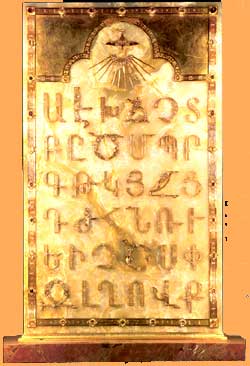
Letters of the Armenian alphabet
|
|
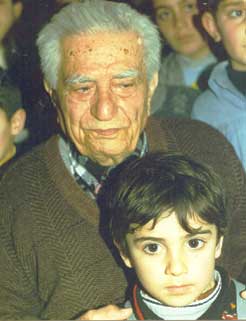
Hayrik Mouradian and
Aram Harutyunyan (5 years old)
|
The next folk song is a unique duet that Komitas recorded and arranged for piano and two voices. But this song, which is exclusively sung by children at ceremonies, festivals, and gatherings in general. Songs of question and answer songs in both literature and music, the song is very active, even taking the form of the theater. And what child doesn’t love theater and the stories it tells?
| 37. |
Haburban - untranslatable…a greeting; a friendly way of addressing someone |
|
- Anoosh, Aram, Lilit Harutyunyan, Mane Nikoghosyan, Mavrik Mkrtchosyan (soloists) and Ensemble
- Gevorg Dabaghyan, duduk - Grigor Takushyan, dham duduk - Kamo Khachatryan, dhol |
|
Girl, your name is Nargis, // you have sat down and are browning wheat on the fire.
Girl, your name is Shushan, // wear you clothes with bells and ringing.
Let St. Karapet be your witness.
|
The next two song, by way of their dialects, are shown to have been written in Van (Vaspurakan region). Hayrik Mouradian learned these songs in the village school in Shatakh and later from Armenian children in Baquba, Iraq. They are songs of humor.
| 6. |
Jakhraki Vot / Vostana Bartsrik Sarer |
|
- Anoosh, Aram, Aroosiak, Lilit Harutunyan, Mane Babayan, Mane Nikoghosyan (soloists) and Ensemble
- Levon Tevanyan, shvi - Kamo Khachatryan, dhol |
|
- Jakhraki Vot - leg of the spinning wheel
|
|
The leg of the spinning wheel is made from the pshat tree, khane (a sound).
The weaver is very young, dear!
The leg of the spinning wheel has many thorns, khane.
The weaver is chubby, dear !
|
|
- Vostana Bartsrik Sarer - high mountains of Vostan (province of Western Armenia)
|
|
High mountains of Vostan, // I can’t weave with the spinning wheel.
The leg of the spinning wheel is thorny. // The weaver is very young.
|
Patriotic songs are presented here, which were originally sung in Vaspurakan (Van) and Moks. Hayrik Mouradian learned these songs from Harutyun Glanyan, who had learned them from the archpriest Natan.
| 25. |
Tesek Aghavnin - see the dove |
|
- Ensemble
|
|
See the dove on Noah’s Ark.
It came and landed on the mountain Tavros.
Spread good news to Haik’s (Armenian forefather) generation.
That spring has arrived for the sons of Torgom (descendant of Noah).
|
| 26. |
Goghtan Mankti - children of Goght |
|
- Ensemble |
|
Children of Goght, for you // a beautiful field of glory.
Hurry, form a group, // let the eternal wreath (for heroes) by yours.
|
Children grow up very rapidly. With the wink of an eye, they are already mothers and fathers, and have become farmers and soldiers for their homeland. And it is very difficult to find that border, where the child is already grown and we, the grownups, then have difficulty realizing that we ourselves are no longer children. Is it not true that many of us still carry the fire of youth and its memories, and then pass this light on to our children?
| 5. |
Tsam is Torge - you left your hair long |
|
- Ensemble - Levan Tevanyan, shvi - Kamo Khachatryan, dhol |
|
A song of dance, danced to the Gyovend melody. It is well known and danced in all regions. It is danced by young and old at various ceremonies. |
|
You left your hair long. // Beautiful, Armenian beauty.
With a round head and small mouth. // Beautiful, dear beauty.
|
| 12. |
Hanik, Nanik, Nanarik - non-translatable |
|
- Anoosh, Aroosiak Harutyunyan, Mane Babayan, Mane Nikoghosyan (soloists) and Ensemble
- Levon Tevanyan, shvi - Kamo Khachatryan, dhol
|
|
A happy children's song which shows respect for nature. It is also danced as a "song of dance," with dancers singing as they dance, usually to the steps of the popular dance "Ververi." |
|
The moon touched the sky // and filled the courtyard with light.
The moon is new, is new // the moon has become full.
The moon shone // and met the clouds, and there it stayed.
|
| 14. |
Krunkner, Barov Yekak - cranes, you came with Goodness |
|
- Anoosh Harutyunyan (soloist) - Grigor Takushyan, dham duduk
|
|
A song of Sasun. It was first recorded in the village of Bazmaberd in the modern Armenian province of Aragatsotn, a region populated by many with roots in Sasun.
|
|
Cranes, cranes.
You came by way of the Sasun mountains.
You came with goodness, cranes.
|
| 16. |
Hayr Mer - our Lord
|
|
- Anoosh (soloists) and Lilit Harutyunyan - Grigor Takushyan, dham duduk and Levon Tevanyan, tav shvi
|
|
This version was found in the Komitas archives. It is written, in his handwriting, in 1915, in Constantinople, on July 2. Also known as “Children’s Prayer". This song was written during the time of the Armenian Genocide, when Komitas returned from exile.
The song was printed in the United States by Komitas’ student Mihran Tumajyan. According to this writing, the song was written for the young students of the Nikoghosyan School.
|
|
Dear Lord, grant us your grace. // Every day, give it plentifully, dear Lord.
Give life to our mother, // give life to our father.
Keep us with your Eyes. // Bless us with the Holy Cross.
Dear Lord, our Protector.
|
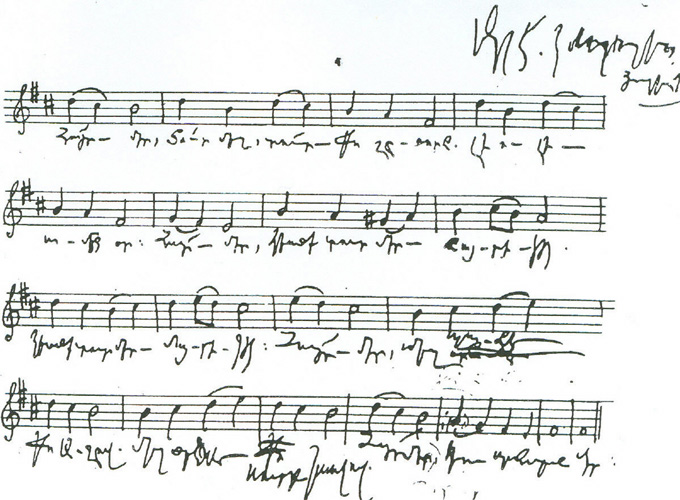
Handwritten notes from the song Hayr Mer - Our Lord
| 22. |
Garnookn oo Mayru - the lamb and the mother
|
|
- Anoosh, Hayk Harutyunyan (soloists) - Karine Hovhannisyan, kanun |
|
One of the songs recorded by Komitas, written for young school children from the first to third grade.
|
|
- Why are you crying, my lamb?
- I was beaten, mother.
- Who beat you, my lamb ?
- A bad old woman, dear mother.
- With what did she beat you, my lamb ?
- With a large stick, my mother.
- Where did she beat you, my lamb ?
- On my feet, dear mother.
- How do you cry, dear lamb ?
- Me`, me`, me`, me`, my mother.
|
| 27. |
Shogher Djan - dear shogher |
|
- Anoosh Harutyunyan |
|
This song was first published in 1907. Several versions were recorded by Komitas. |
|
Clouds have gathered, snow isn’t falling.
Dear Shogher.
The boy hasn’t come back from the mountain.
Dear Shogher.
Rock in the wind, wave in the wind.
Dear Shogher.
Snow has appeared from the clouds.
Dear Shogher.
|
| 29. |
Tiramor Govku - praise of the Mother of God
|
|
- Anoosh Harutyunyan (soloists) - Grigor Takushyan, dham duduk
|
|
This is a song of pilgrimage, first recorded in Yerevan. The words were written by Vardan Khoyetsi (Khoy is a region in Persian). This is one of a group of songs in which the author is known, yet the melody has certain distinct characteristics of the troubador (ashoughakan) song.
|
|
I believe in You, I humble myself before You.
Eternal Mother of God.
I kneel before your temple.
Honorable and holy Mother of God..
|
- map sketch: The Oriental Empire
Greater Armenia
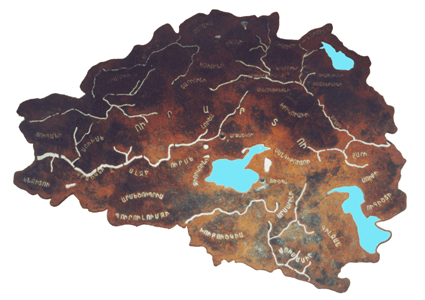
- map sketch: Armenia today
Instruments:
|
- Duduk, dham duduk (wind instrument)
|
|

Gevorg
Dabaghyan |
 Grigor
Grigor
Takushyan
|
Armenian oboe. A single or double reed wind instrument made of apricot wood with a sound that has a humanlike voice quality. It has a cylindrical wooden pipe, a broad reed and nine holes (8 finger-holes and one thumb-hole). It has a warm, soft, slightly nasal timbre and full tone. This instrument is equally used for slow lyrical tunes (accompanying folk songs) and faster dance-tunes and it is also played solo. The tuning is basically untempered diatonic, though chromatic notes can be obtained by partially opening or closing the finger holes. The double reed is a slit-tube-like reed. The origin of the duduk goes back to times before Christ.
|
|
|
- Shvi, tav shvi (wind instrument)
|
|
 Levon
Levon
Tevanyan
|
The Shvi is an Armenian end-blown duct flute, made of reed or wood, with a mouth-piece similar to a recorder. It has seven finger-holes and one thumb-hole and an average lenght of 32 cm. At the upper end, near the mouthpiece, there is a metal (usually tin) ring for adjusting the sound. It can be made in various sizes and it is played solo and in ensembles of folk instruments. The shepherds sometimes play it in place of the more difficult pastoral flute "blul".
|
|
|
- Kanun (string instrument)
|
|
 Karine
Karine
Hovhannisyan
|
The kanun is a plucked box zither of the Middle East, North Africa and parts of Asia. It is trapeziform in shape, one of the sides being rectangular. Armenian models never have more than two string-levers. To play the instruments, the musicians place it either on their knees or on a table. The strings are plucked by ring-shaped plectra put on the index fingers. The range of the kanun varies between three and four octaves. In Armenia it is played as a solo instrument or in ensembles. The instrument has 24 triple courses of gut strings tuned to a diatonic scale of D major.
|
|
|
- Dhol (percussion instrument) |
|
 Kamo
Kamo
Khachatryan
|
Double-headed cylindrical drum. One membrane is thick and produces a deep sound, the other is thinner, generating a higher pitch. The membranes are made of sheepskin or goatskin, which are tensioned to each other by a variety of zigzag lacing around the cylinder. It is either played with two wooden sticks (one usually thicker than the other) on both membranes, or with the fingers and palms on one membrane. A variety of dances and songs are accompanied by the dhol. Many rhythmic patterns are used, giving the music an improvisatory character and its beat. In medieval times, the dhol was also known as the gos.
|
|
|
- Dap - frame drum (percussion instrument)
|
|
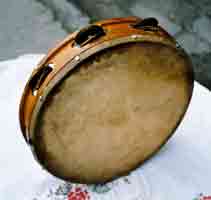  |
The Dap is a single-headed Armeniam frame drum, equivalent of the Arab duff. the wooden frame ist 35 to 50 cm in diamenter, with jingles (metal rings, rattles, silver coins etc) attached inside the frame and sound when the drum is played or shaken. By striking the centre od the edge of the membrane, sounds of differing pitch and timbre can be produced. |
|
English translation by Andranik Michaelian
More information about musicians, history and religion of Armenia you will find in Ensemble Karot
- Vol. I (FM 50033) and Vol. II ( FM 50034).
|
